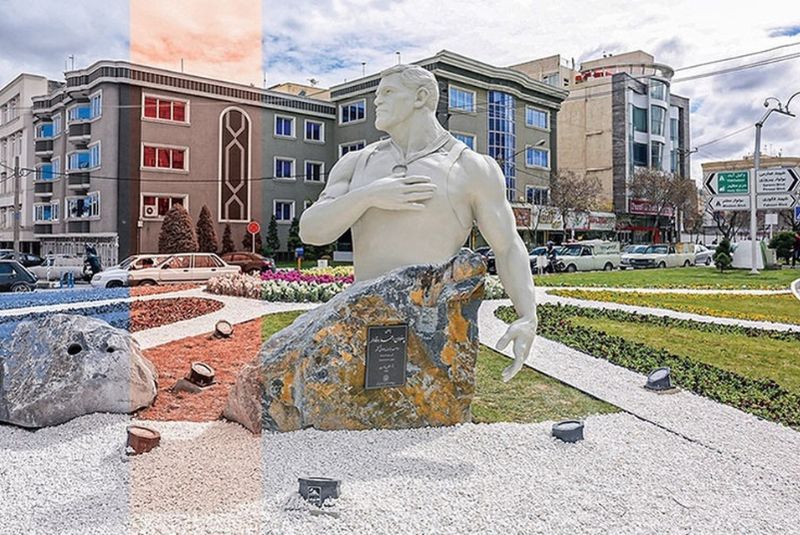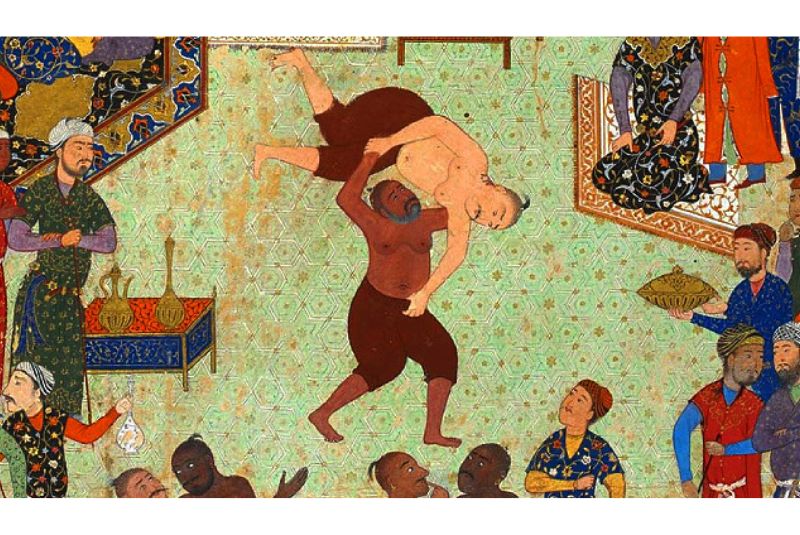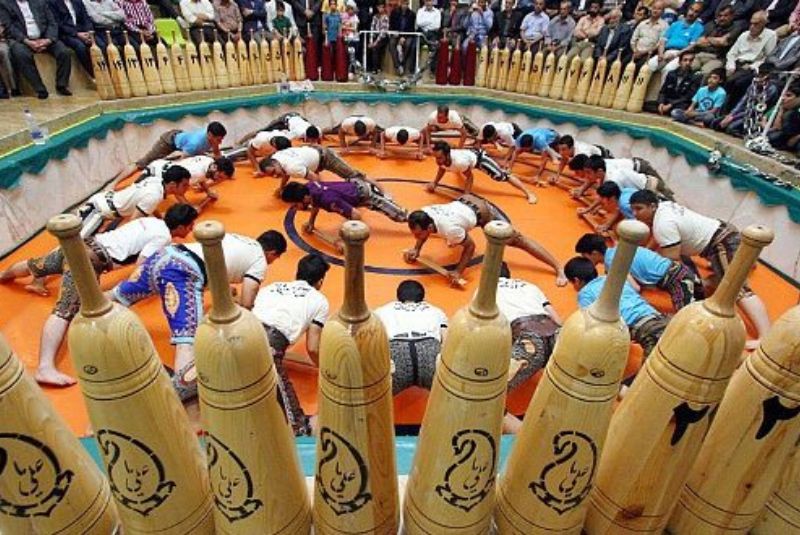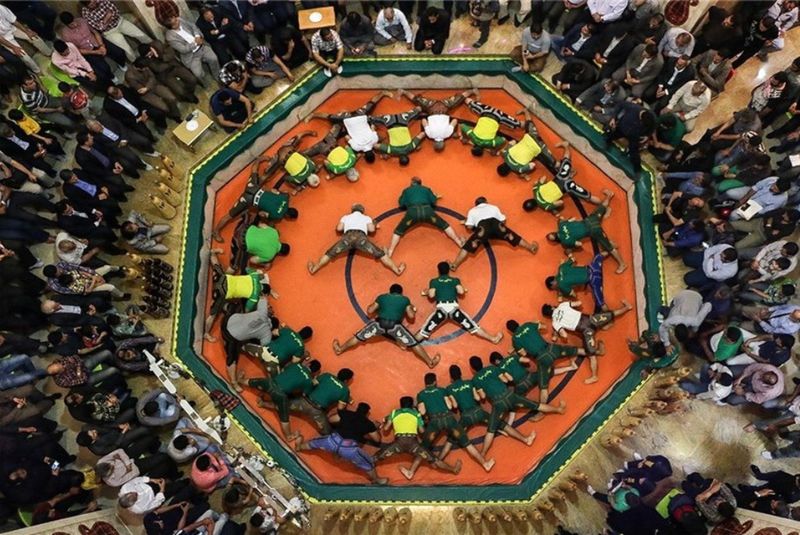Pahlevani and Zoorkhaneh Rituals | An Ancient Sport
Throughout history, many sports have evolved, shaped by geography, culture, and the passage of time, to serve as a reflection of a nation's values, history, and cultural identity.
Pahlevani and Zoorkhaneh rituals originate from ancient Iranian athletics that embody the essence of Iranian tradition, representing far more than mere sports.
Primarily known for its wrestling component, this ancient practice encompasses much more. It involves a series of gymnastic movements and culminates in combat practice, tracing its origins back hundreds of years to ancient Persia. However, its significance extends beyond the realm of physicality. Within this blog, we invite you to dive deep into Iran's ancient athletics, immersing yourself in the Pahlevani and Zoorkhaneh rituals that accompany them and unraveling the profound meanings that lie within.
What is Zoorkhaneh?
Zurkhaneh meaning " house of power" or "house of strength," is a traditional gymnasium where Varzesi Bastani is practiced. While they are less prevalent today, you can still find them in older parts of cities. These unique gymnasiums were designed to emphasize the ritualistic nature of ancient Iranian athletics.

The architectural design of Zoorkhanehs is quite distinctive. They feature a domed structure with a single round opening in the ceiling, symbolizing the sun and allowing natural light to illuminate the space. This design ensures that all attention is focused on the sports being performed at the center. At the heart of the Zoorkhaneh is the "gawd," a sunken circular pit about one meter deep. This is where gymnastics, calisthenics, and wrestling take place. Surrounding the gawd, athletes and spectators sit in a circular arrangement.
The Morshed, a knowledgeable and well-read individual with a deep understanding of Iranian epic poetry like Shahnameh, reciting these poems and singing Zoorkhaneh music to the athletes, sits in a higher position than others. The Morshed also oversees and orchestrates the athletes' performances. This elevated position is not only practical for better visibility but also a sign of respect. The Morshed is often an elderly and wise individual, and Iranians have a deep reverence for their elders. It is a core belief in Zoorkhaneh culture to show respect to those who are highly regarded.
When visiting a Zourkhaneh, you'll notice that the gaud is intentionally positioned lower than the rest of the structure. This is to ensure better visibility for the audience and to instill a sense of selflessness. Modesty holds great importance in ancient Iranian teachings and rituals, and it remains a highly valued virtue today. As you enter the Zourkhaneh, you'll observe the placement of the door and the entrance, prompting a slight bow and lowered head. This serves as a reminder to remain humble not only in the presence of God but also in our interactions with others.
| Discover: Chogan (Polo) - A Horse-Riding Game Originated in Iran
Zurkhaneh History
In ancient times, sports served a dual purpose: Preparing men for war and providing enjoyable physical activity during periods of peace. This led to the inclusion of performative elements in sports worldwide, adding an extra layer of excitement and entertainment.

The origins of Zourkhaneh can be traced back to the reign of the Parthians, who ruled the Persian empire from 247 BC to 224 AD. Athletes would gather in a unique structure known as Zourkhaneh, a domed building specifically designed for physical training. Inside the Zourkhaneh, they would engage in exercises following established orders while being accompanied by music and poetry.
A Morshed, a knowledgeable and well-read individual, played a crucial role in this setting. With a deep understanding of Iranian epic poetry like Shahnameh and the works of great poets like Mowlana, the Morshed would recite these poems and sing them to the athletes. Their purpose was twofold: To motivate and inspire the athletes while imparting the moral lessons of great heroes. The Morshed would often play the drum, coordinating the movements of the athletes with the rhythm of the music.
| Suggestion: Sama Dance - Unraveling the Mystical Beauty of an Ancient Dance
What Does Pahlevani mean?
The word "Pahlevan" originates from the Parthian language and is still used in Persian, spoken by Iranians, Tajiks, and Afghans. It holds a special meaning: Hero.

As the name suggests, the essence of ancient Iranian athletics can be found in the qualities attributed to heroes. These are brave and noble acts performed by kind-hearted men who deeply care for their country and their people.
These attributes and characteristics are beautifully depicted in the epic Shahnameh by the great poet Ferdowsi. In Shahnameh, also known as the Book of Kings, Ferdowsi not only tells stories of kings but also introduces remarkable heroes, or Pahlevans, who come to the aid of their kings and people during challenging times, leading their nation to greatness. One of the most famous heroes from Shahnameh is Rustam.
Rustam's legend extends far beyond Iran; he is widely recognized in countries like India, Turkey, Afghanistan, and more. He is the hero who rises during the toughest moments to defend his country, uphold morals, and protect his people. Rustam's deep love and care for his people are so profound that he is even willing to sacrifice his own life to help them.
Another significant figure in Zourkhaneh culture is a renowned Pahlevan named Pouria Vali, who is well-known throughout Iran. Pouria Vali is both an athlete and a Sufi, embodying the characteristics of a true Pahlevan. Many Zourkhaneh establishments in Iran proudly bear his name.
These are the stories recited within Zourkhaneh, inspiring the athletes and filling them with a sense of pride, duty, and a profound love for life. Traditional Iranian wrestling, known as "Koshti," is believed to have been practiced and performed by Rustam himself. It has become an integral part of Iranian combat training and is now referred to as "Varzesh-e-Baastani" (Ancient Sport) and "Koshti-Pahlevani" (Heroic Wrestling). Today, it is practiced in sports complexes and Zourkhaneh throughout the country. It has also gained global recognition as UNESCO has declared it a cultural heritage of Iran.
History of Varzesh-e-Bastani
So now that you know what Pahlevani and Zourkhaneh's history is, let's talk about the Varzesh-e-Baastani. The sport has its roots in ancient Persia, specifically during the Achaemenid era. Its original purpose was to train men as warriors for upcoming battles. In fact, the entire Zoorkhaneh workout mirrors the strategies and skills needed on the battlefield. It combines various elements such as martial arts, calisthenics, gymnastics, strength training, and even music.
This sport is a unique fusion of different aspects of Persian culture, including pre-Islamic influences from Zoroastrianism, Mithraism, and Gnosticism. It is often referred to as Varzesh-e bastani, meaning "Ancient Sport," and its distinctive wrestling style is known as Koshti Pahlevani, Traditional Iranian Wrestling.

During the Safavid era, with the rise of Shi'ism as the predominant Islamic sect, the sport assimilated religious elements from Shia teachings. A Pahlevan, or hero, undergoes a transformative journey that encompasses both the physical and spiritual aspects of life, striving to attain moral virtues, bravery, and physical strength.
As a result, a Pahlevan becomes not only a symbol of physical prowess but also a paragon of morality. They are highly revered and admired by the people. In fact, Imam Ali, the first Shi'ite Imam, was regarded as the patron of Zurkhaneh, further solidifying the sport's cultural and religious significance.
During the reign of the Qajar kings, the sport reached the heights of popularity. However, it experienced a decline during the Pahlavi dynasty. Reza Shah, the first Pahlavi king, considered the sport to be associated with outdated Qajarite rituals and aimed to modernize Iran. Nevertheless, his son, Mohammad Reza, took a different approach, recognizing the importance of preserving ancient Persian traditions, including the Pahlavani rituals.
The Pahlavani rituals, with their heroic nature, have always enjoyed great popularity not only in Persia but also in other countries in Western Asia. They can be found in Azerbaijan and were even introduced to Iraq in the 19th century, showcasing the enduring influence and reach of this ancient sport.
| Suggestion: White Water Rafting in Iran
The Pahlevani and Zoorkhaneh Rituals
Pahlevani and Zoorkhaneh rituals are deeply rooted in Sufi traditions, and we can see this through the use of terms like "Mashed" or "Morshud" (meaning "Master"), "Pishkesvat" (meaning "Leader"), "Taj" (meaning "Crown"), and "Fakr" (meaning "Pride"). These rituals aim to honor and uphold tradition. They also share ethical values with Sufi ideals, placing a strong emphasis on purity of the heart.
Each session begins with a wudu, which involves washing various parts of the body, such as the hands, mouth, nostrils, arms, head, and feet, with water.
As you enter the Zoorkhaneh, you'll notice a unique feature—a low entrance door. This is done out of respect for the Zoorkhaneh, and athletes must bow as they pass through the door, symbolizing humility and reverence.

Inside the Zoorkhaneh, there's a special place called Sardam. It's where the Morshed, a person with a significant role, sits and sings songs praising Prophet Muhammad and his family. The Morshed also sets the rhythm by playing a unique Zurkhaneh equipment known as Zarb-e Zoorkhaneh (goblet drums) while reciting Gnostic poetry and stories from Persian mythology.
During the ritual, athletes stand in a circle and perform specific moves following the instructions of a person known as the "Morshed." They perform the moves either with or without Zurkhaneh equipment like the "Mil" (steel bar), "Kabbadeh" (bow), "Sang" (stone), and "Takhteh Shena" (push-up board).
The Mil is similar to a mace used in ancient times, while the Kabbadeh represents the soldiers' bows from the past. The Sang, two horseshoe-shaped stone pieces, resemble soldiers' shields and weigh around 20 kilograms each. The Takhteh Shena, or push-up board, is used for quadruple push-ups in the Zoorkhaneh workout.
The training ground is called the "Gowd." In the past, the Morshed trained soldiers and athletes, instructing them with a wooden stick. Nowadays, the Morshed only sits in a chamber near the entrance door, leading the athletes with the beats of the Zarb and the ringing of the "Zang." The Zang is a bowl-shaped copper ring hung above the Morshed's head in his chamber.
When a senior member enters the Zoorkhaneh, the Morshed rings the Zang. This ring serves as a harmonizing element, guiding the athletes through each move and indicating when to transition to the next one.
In the past, singing served as a means of oral education, imparting social knowledge, moral codes, and religious teachings to warriors in training. Today, a significant part of Varzesi Bastani's sessions focuses on paired weight training and calisthenics. The participants also engage in activities like Sufi whirling and juggling, all performed in synchrony with the beat of the taiko drums.

Each session concludes with a Koshti Pahlavani match, showcasing the traditional Iranian wrestling that has its roots in ancient Zoroastrian beliefs. The Zoroastrians believed that developing physical and mental strength could enhance spirituality. Therefore, beyond preparing warriors for battle, this training aims to promote kindness and humility by cultivating outer strength. After the intense Zoorkhaneh workouts, athletes receive relief from fatigue through a massage provided by a person known as "Moshtomal chi."
Under the guidance of the Pishkesvat (Champion), students are taught traditional ethics and chivalry. Participants are expected to embody purity, honesty, good temper, and, for the first time, physical fitness. To achieve the prestigious title of Pahlevan (Hero), one must demonstrate mastery of physical skills, adhere to religious principles, and progress through the moral stages of Gnosticism.
A core principle emphasized in these gatherings is the value of humility. This is beautifully captured in a verse often recited during the meetings: "If you want knowledge, learn humility. Rivers will never irrigate the highlands" (Kantz ol-Hagaig).
In addition, in the Zoorkhaneh, athletes use a specific word called "Rokhsat" to show respect to the elder members. Rokhsat means seeking permission, and it highlights the importance of acknowledging and honoring the wisdom and experience of the older generation.
Golrizan (Casting of Flowers)
Another unique tradition in Zourkhaneh is Golrizan. In a Zourkhaneh, there is no fee to enter, whether you're an athlete or a spectator. However, when someone is going through a difficult time and needs financial support, a special ceremony called Golrizan takes place. Golrizan, which translates to "casting flowers," is a ritualistic gathering within the Zourkhaneh.
During Golrizan, the person in need of assistance can choose to remain anonymous if they wish. Instead of focusing on the individual, the ceremony aims to address the problem as a collective. Anyone who wants to lend a helping hand can participate in this ceremony.
In this heartfelt gathering, the audience casts rose flowers into the gawd, a symbolic pit or receptacle. Each flower represents a gesture of joy and happiness, symbolizing the collective support pouring down like rain.
Through the act of casting flowers, the Zourkhaneh community comes together to share the burden of someone's hardship. It's a beautiful way to show solidarity and provide assistance without singling out or embarrassing the person in need.
Zoorkhaneh sport in modern Iran
While the spiritual significance of the Zoorkhaneh sport and ritual may have diminished over time, it still holds a unique charm and cultural value. If you're planning a trip to Tehran, you're in luck because there are around 50 active Zoorkhanehs in the city as well as some in other cities throughout Iran, where locals continue to exercise at these traditional gyms.
| Check out our Iran tour packages to find the best one suits you!
Visiting one of these Zourkhanehs presents a wonderful opportunity to delve deeper into this ancient sport and witness live performances firsthand.

You can observe the athletes as they engage in their rhythmic movements, listen to the captivating Zoorkhaneh music, and witness the coordination and strength displayed during their performances.
Let's take a closer look at some of the most famous Zoorkhanehs in Iran:
1. Pahlevan Pour Zoorkhaneh - Tehran
This Zoorkhaneh, established in 1925 during the early Pahlavi Dynasty, is one of the oldest in Iran. It was founded by Hamzeh Ali Pahlevan Pour, a renowned champion of Tehran. Hamzeh used the income from his stores in Tehran's bazaar to support the poor and young athletes.
| Check out: Tehrna Tours
2. Pahlevan Ali Mirza - Hamadan
Pahlevan Ali, an esteemed champion, built this Zoorkhaneh in Hamadan, a city in western Iran. He earned the title of Pahlavan at the age of 60 and continued wrestling until he was an incredible 95-year-old.
3. Poolad Zoorkhaneh - Shiraz
The Pahle Ritual held a special place in the culture of the people of Shiraz. The Poolad Zoorkhaneh was initially constructed during the late Zand Dynasty as a water reservoir in the Zand complex. After 130 years, champion Ali Kolahi renovated it into a Zoorkhaneh. Today, after 160 years, it still serves as a traditional gym for the locals of Shiraz.
| Check out: Shiraz Tours
4. Saheb al Zaman Zoorkhaneh - Yazd
Situated in the heart of the historic city of Yazd, this Zoorkhaneh is a must-see in Iran. It remains active and exudes a nostalgic atmosphere with its stunning design. Similar to the Poolad Zoorkhaneh in Shiraz, this Zoorkhaneh was also originally a water reservoir before being transformed into a traditional gym.
| Check out: Yazd Tours
5. Ali Gholi Agha - Isfahan
This Zoorkhaneh is one of the oldest in Isfahan and is considered one of the lesser-known tourist attractions in the city. Due to its antiquity and significance, the Ali Gholi Agha Zoorkhaneh is known as the capital of Pahlevani rituals in Iran. It serves as the venue for Pahlevani competitions.
| Check out: Isfahan Tours
Famous Athletes of Zoorkhaneh in Iran
The world of Zoorkhaneh has produced some truly remarkable athletes who have gained fame and admiration in Iran. These individuals have not only excelled in their respective sports but have also become cultural icons, inspiring countless young Iranians to embrace these ancient traditions and carry them forward. Some of the most renowned Zoorkhaneh athletes include Pourya-ye Vali, Fileh Hamedani, Ali Hagh Shenas, Musa Khamis, Akbar Khorasani, Ebrahim Hallaj Yazdi, Parviz Montazer, Hosein Golzar, Hasan Razaz and Sadegh Bolourforoush.
Bottom Line
Pahlevani and Zurkhaneh are not merely sports or rituals; they are living embodiments of Iran's rich history, culture, and values. These ancient traditions have withstood the test of time, evolving into a symbol of strength, discipline, and spiritual connection. From the rhythmic movements and captivating beats of the Zarb to the awe-inspiring displays of physical prowess, Pahlevani and Zurkhaneh rituals offer a glimpse into a world where mind, body, and spirit are harmoniously united.
Did you find this article informative and helpful?
Comment below and let us know about your Experience.
Your story inspires others!


0 Comment
Leave a Comment